Market Data

January 13, 2020
December Net Job Creation Down from November
Written by Peter Wright
The number of jobs created in December declined from the excellent November result on a seasonally adjusted basis.
Net job creation in December declined to 145,000 from November’s exceptional result of 256,000. October and November were both revised down by 10,000. Rising employment and wages are the main contributors to GDP growth because personal consumption accounts for almost 70 percent of GDP. Steel consumption is related to GDP; therefore this is one of the indicators that help us understand the reality of the steel market
![]()
Figure 1 shows the three-month moving average (3MMA) of the number of jobs created monthly since 2000 as the brown bars and the total number employed as the black line. Economy.com summarized as follows: “Payrolls increased by 145,000 jobs in December, below our expectation and consensus, while the unemployment rate was unchanged at 3.5%. Revisions to previous months were small. The labor market remains solid, though it shifted down in 2019. Retail was strong, in part due the seasonal effect of the late Thanksgiving, as well as healthcare and leisure/hospitality. Detracting from the top line were manufacturing, transportation and warehousing, which reflected the challenging conditions in the factory sector.”

Figure 1a shows the raw monthly data since January 2018 and that the variability has been worse in 2019 than it was in 2018. The average monthly job creation in 2018 was 223,300, and in the 12 months of 2019 was 175,700.
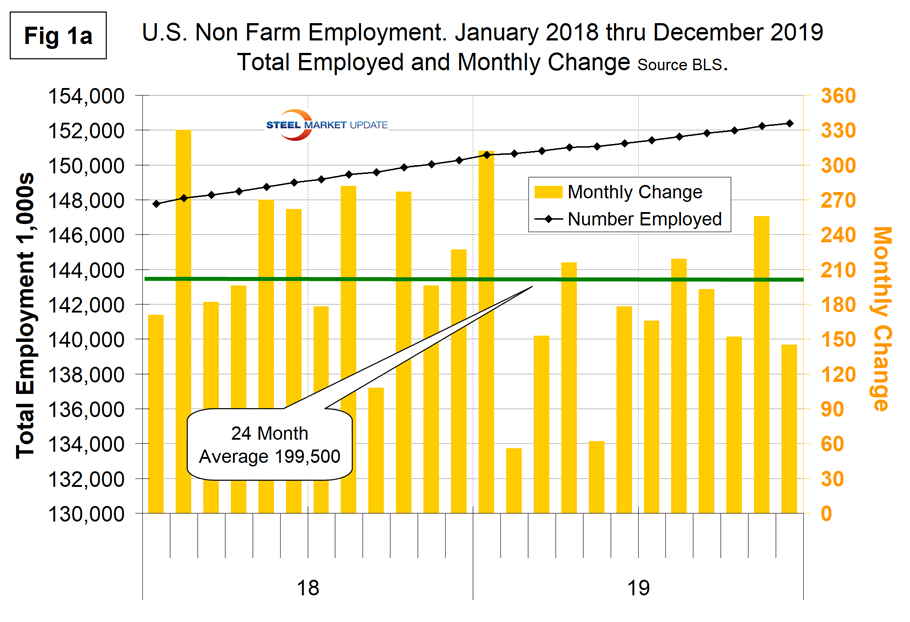
We prefer to use three-month moving averages in our analyses to reduce short-term variability. In averaging employment statistics in this way we even out what is notoriously volatile data.
The employment data has been seasonally adjusted. We have developed Figure 2 to examine if any seasonality is left in the data after adjustment. We think it’s significant to look at the results this way because there is so much variability in the numbers that a long-term context is necessary. It doesn’t look as though the BLS seasonal adjustment is very effective. In the nine years since and including 2011, the average month-on-month change from November to December has been negative 5.3 percent. This year the change was negative 43.4 percent, partly because November was swelled by GM workers coming back off strike.
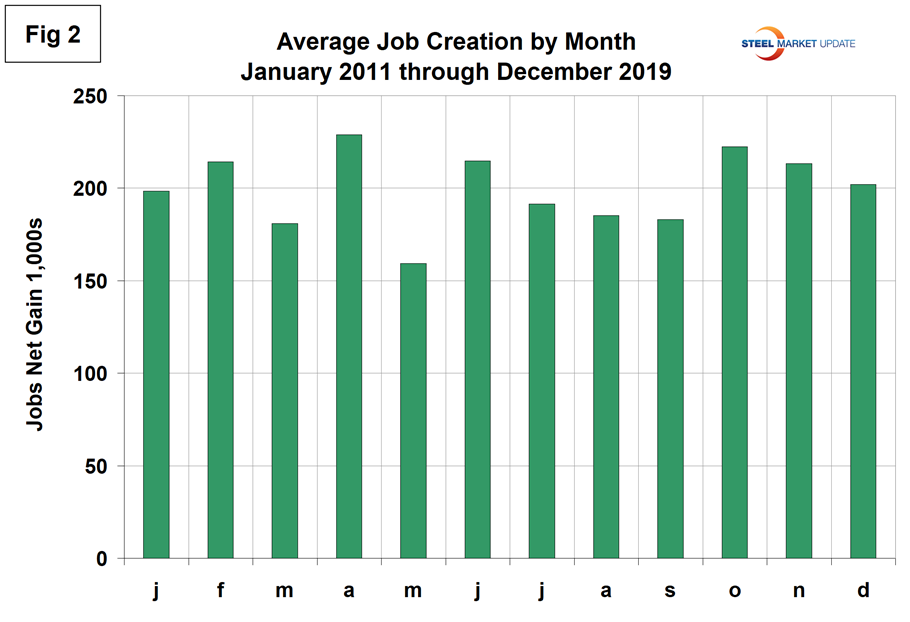
In order to get another look at the degree of change, we have developed Figure 3. This shows the same total employment line as Figure 1 but includes the year-over-year growth on a percentage basis. It shows more clearly the steady improvement that occurred during 2018 and the slowdown in the first half of 2019. Considering the variability of the raw monthly data, we think the year-over-year view is the best way to evaluate what’s really going on.
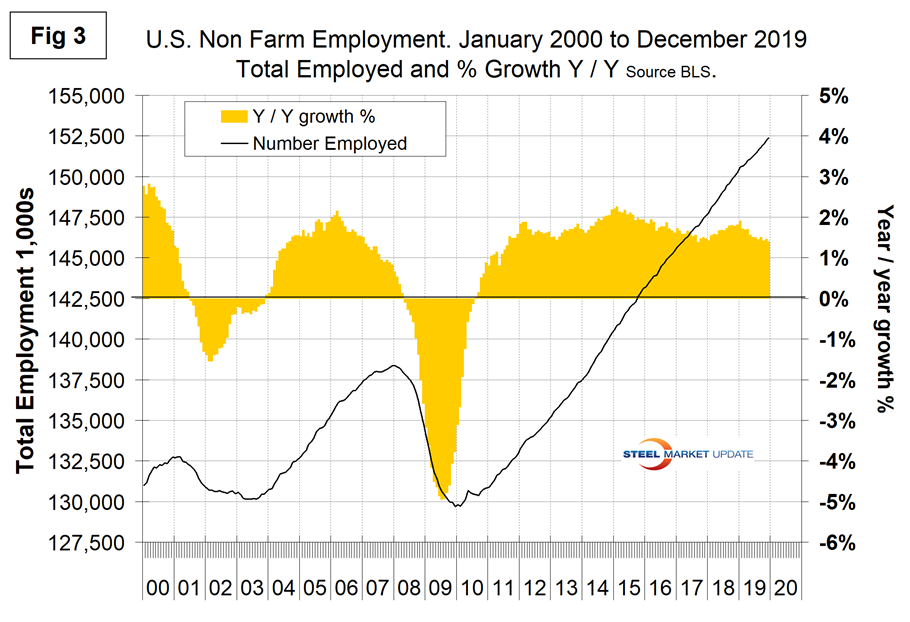
According to the latest BLS economic news release, average hourly earnings for all employees on private nonfarm payrolls rose by 3 cents to $28.32 in December. Over the last 12 months, average hourly earnings have increased by 2.9 percent. In December, average hourly earnings of private-sector production and nonsupervisory employees, at $23.79, were little changed (+2 cents). The average workweek for all employees on private nonfarm payrolls was unchanged at 34.3 hours in December. In manufacturing, the average workweek and overtime remained at 40.5 hours and 3.2 hours, respectively. The average workweek of private-sector production and nonsupervisory employees held at 33.5 hours.
The official unemployment rate, U3, reported in the BLS Household survey (see explanation below) declined from 3.7 percent in June, July and August to 3.5 percent in November and December. U3 has ranged from 3.5 to 4.0 percent in each of the last 18 months. This is not a very representative number. The more comprehensive U6 unemployment rate at 6.7 percent was down from 8.1 percent January (Figure 4). The difference between these two measures in December was 3.2 percent, which is historically excellent and the lowest since April 2001. U6 includes individuals working part time who desire full-time work and those who want to work but are so discouraged they have stopped looking.
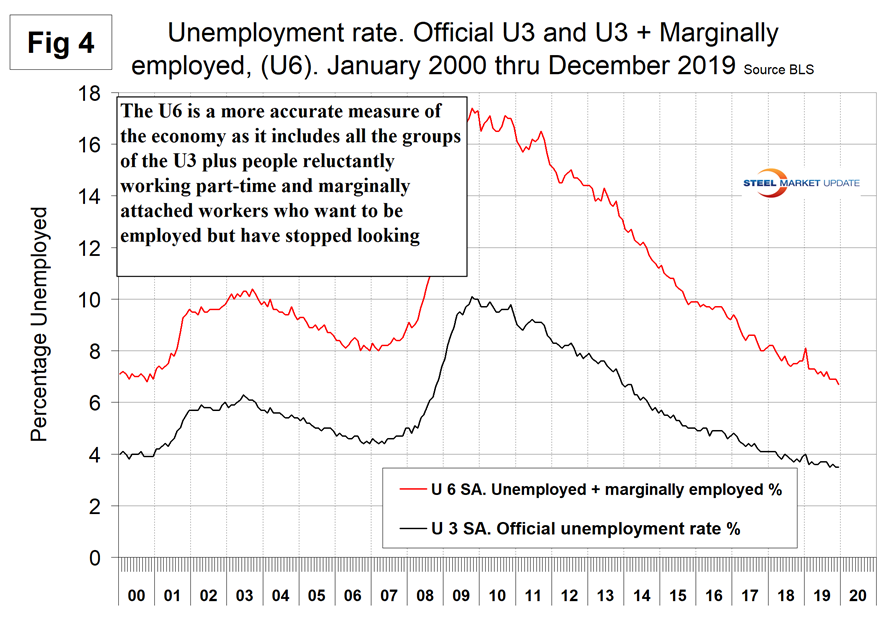
The labor force participation rate is calculated by dividing the number of people actively participating in the labor force by the total number of people eligible to participate. This measure was 63.2 percent in December and hasn’t changed much in three years. Another gauge is the number employed as a percentage of the population, which we think is more definitive. In December, the employment-to-population ratio was 61.0 percent, the best result since December 2008. Figure 5 shows both measures on one graph.
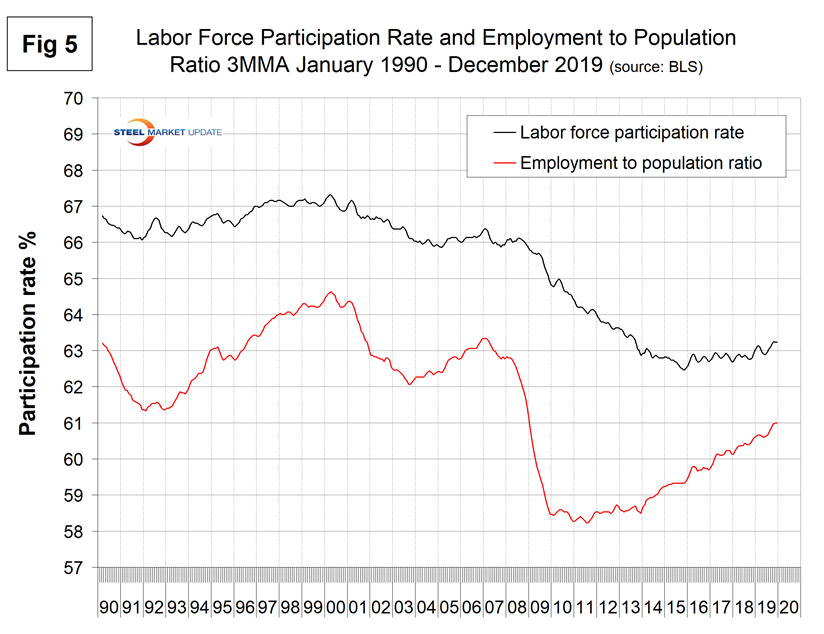
In the 48 months since and including January 2016, there has been an increase of 9,015,000 full-time and a decrease of 386,000 part-time jobs. Figure 6 shows the rolling 12-month change in both part-time and full-time employment. This data comes from the Household survey and part-time is defined as less than 35 hours per week. Because the full-time/part-time data comes from the Household survey and the headline job creation number comes from the Establishment survey, the two cannot be compared in any given month. To overcome the volatility in the part-time numbers, we look at a rolling 12 months for the full-time and part-time employment picture shown in Figure 6.
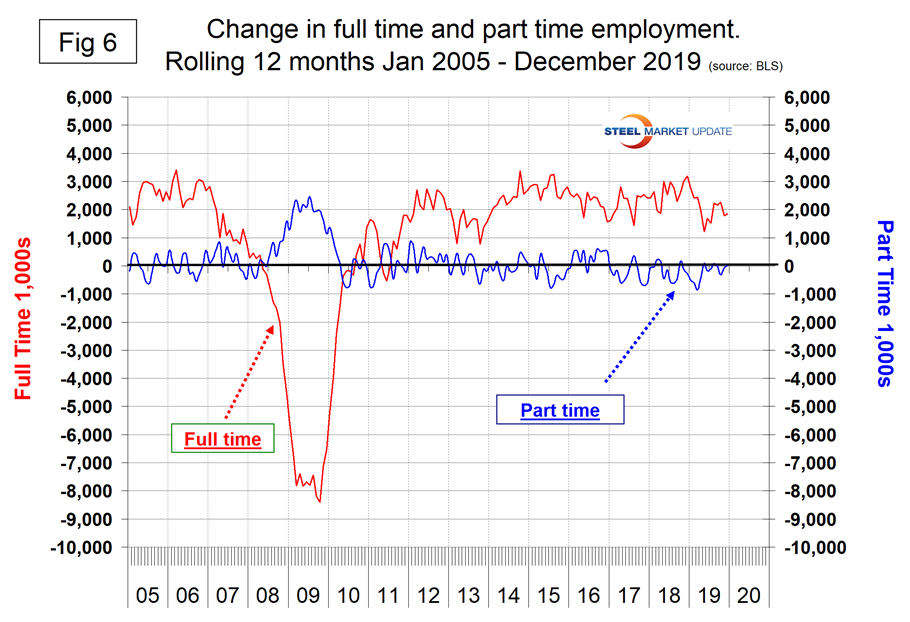
The job openings report known as JOLTS is reported on about the 10th of the month by the Federal Reserve and is over a month in arrears. In the December employment report, JOLTS data was reported for October. Figure 7 shows the history of unfilled jobs. In October, openings stood at 7,267,000, which was still historically high and up from 7,032,000 in September. There are still more job openings than there are people counted as unemployed.
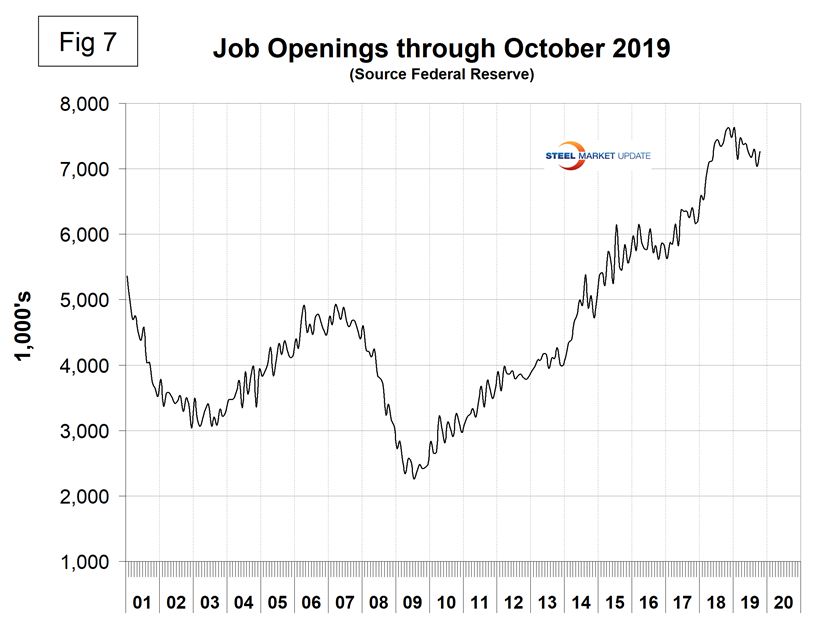
Initial claims for unemployment insurance, reported weekly by the Department of Labor, have been exceptionally low since 2014. The U.S. is enjoying the longest streak since 1973 of initial claims below 300,000 (Figure 8). This data stream is part of our recession outlook report and at present shows no sign of an imminent problem.
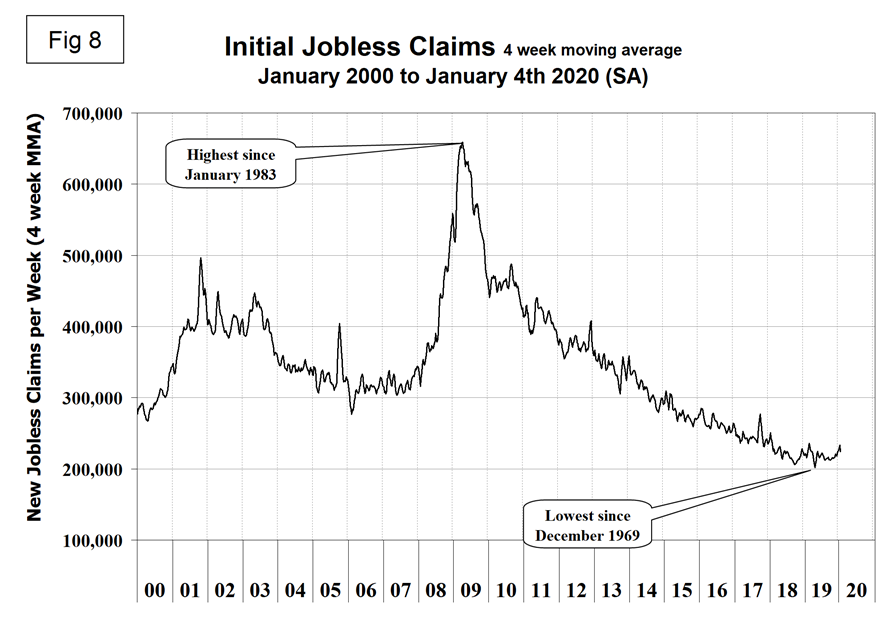
Challenger Grey and Christmas Inc. produce a monthly report of job cuts in the U.S. Job cuts were 32,800 in December; the average for the year was 49,400. Economy.com reported: “Job cut announcements fell to 32,843 in December, dropping 26% from November and 25% from a year earlier. Total job cuts for 2019 reached 592,556, the highest annual total since 2015. December layoff announcements were concentrated in the automotive and transportation industries. Retail announced the most job cuts of any industry for the third consecutive year. Mining industries experienced the largest percent increase in layoff announcements from 2018 to 2019.”
(Note: Economy.com is reporting an annual total, we are reporting a rolling 12 months, which shows a recent improvement.)
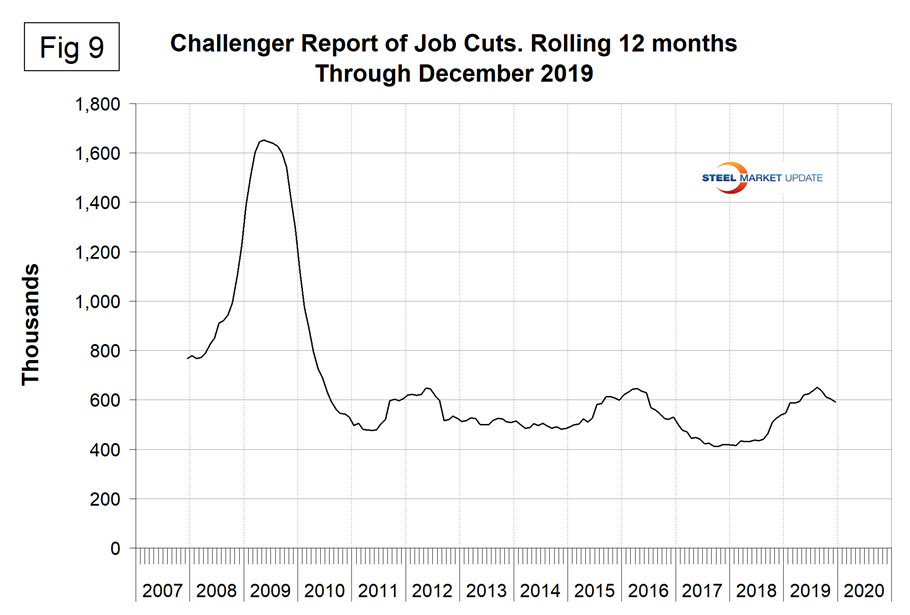
SMU Comment: The December employment report took a step back from November’s excellent result. December came in at 145,000, which was below par. (Remember, these numbers are seasonally adjusted.) The rate of job creation fell from 223,300 per month in 2018 to 175,700 in 2019.
Explanation: On the first Friday of each month, the Bureau of Labor Statistics releases the employment data for the previous month. Data is available at www.bls.gov. The BLS reports on the results of two surveys. The Establishment survey reports the actual number employed by industry. The Household survey reports on the unemployment rate, participation rate, earnings, average workweek, the breakout into full-time and part-time workers and lots more details describing the age breakdown of the unemployed, reasons for and duration of unemployment. At Steel Market Update, we track the job creation numbers by many different categories. The BLS database is a reality check for other economic data streams such as manufacturing and construction. We include the net job creation figures for those two sectors in our “Key Indicators” report. It is easy to drill down into the BLS database to obtain employment data for many subsectors of the economy. For example, among hundreds of sub-indexes are truck transportation, auto production and primary metals production. The important point about all these data streams is the direction in which they are headed. Whenever possible, we try to track three separate data sources for a given steel-related sector of the economy. We believe this gives a reasonable picture of market direction. The BLS data is one of the most important sources of fine-grained economic data that we use in our analyses. The states also collect their own employment numbers independently of the BLS. The compiled state data compares well with the federal data. Every three months, SMU examines the state data and provides a regional report, which indicates strength or weakness on a geographic basis. Reports by individual state can be produced on request.






